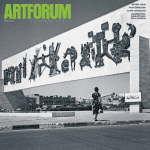
MARCH 2023, VOL. 61, NO. 7
Alexandra Gelis and Carlos Martiel
“Gente de color” (People of Color), a two-person exhibition featuring the work of Alexandra Gelis and Carlos Martiel, was named after a performance by the latter. As applied to the show as a whole, the phrase functioned as a bitter metaphor for the contradictions of the Caribbean, a region rife with exploitation, inequality, and mass tourism, but also as a description of the creative hybridity produced by the continual mixing of peoples, traditions, and cultures. The Toronto-based, Colombian Venezuelan Gelis combines various media and interactive technologies to investigate specific Latin American sociocultural contexts. In Raspando la ciudad (Scraping the City), 2011–22, for example, she transforms a raspao—the traditional cart from which street hawkers sell granita, frequently encountered on Colombia’s Caribbean coast in her native Cartagena—into a modified readymade. The crank that shaves the ice also activates two video cameras: one focused on the vendor’s interaction with the customer and another on the surrounding environment. This footage live streams on a screen installed on the cart’s side and is uploaded on a dedicated website. Gelis pays the vendors a salary for their work, supplementing their usual revenue from sales of the granita. In its ordinary urban context, the cart maintains its original function of social aggregation and commerce. But when the work is presented as an installation in an art context, the built-in monitor shows images of the cart’s construction, a collaborative project among residents of Cartagena’s working-class Bosque neighborhood.
Martiel, on the other hand, aligns his own body—identified with the “social body”—in ritual-like actions that criticize systems of power and injustice based on race, migration, and isolation. Working in his native Havana and New York City, the artist has constructed a consistent body of work that touches on the very core of the human experience in symbolic reenactments of sorrow, suffering, survival, and privation that are inflected by current events or linked to repressed historical circumstances. Gente de color, 2018, originally conceived for the Fourteenth Cuenca Biennial, broached the segregation suffered by populations of African descent in Ecuador. It was shown here through photographic documentation, alongside photos of other performances that helped contextualize Martiel’s action at the exhibition’s opening: Despojo(Spoils), 2022. In heroic nakedness, the artist stands upright, hands tied in front of him, against a wall painted with the colors of the flag of Chocó, a department that stretches across the northern half of Colombia’s Pacific coast. The invocation of Chocó is significant because the Spanish conquistadors built the first cities in South America in this area. After centuries of exploitation, the indigenous communities and people of African descent who inhabit the region continue to struggle with problems of health, education, employment, and civil strife. The dramatically underdeveloped province is Colombia’s poorest, with one of the country’s highest rates of displacement. A construction separating the performance from the public was built from corrugated-zinc sheets riddled with bullet holes, obstructing the view of the artist’s body. The public, transformed into accidental voyeurs, could then violate the false privacy of the artist by spying on him through the holes.
Translated from Italian by Marguerite Shore.

